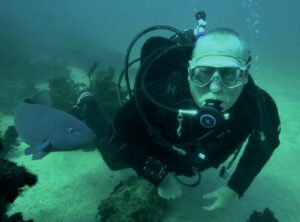Wearing a wedding ring is clearly a statement, yes, but, ladies and gentlemen, do you really need to wear a ring while scuba diving? Caren Liebscher says read this story – and think about it.
It was around Christmas time, the holiday season 2014/2015, when DAN Europe were reported two similar cases. Two DAN members in different places of the world – the Maldives and Brazil – almost lost their ring fingers while diving.
Who wouldn’t hold on to some railing on a shaky boat because another boat passed by too close, or sea conditions were a bit rough? That’s what the men did while getting ready for the giant stride to start their dives. However, watch out for screws, hooks or other tiny metal pieces sticking out of such a railing! For example, hurricane cover screws can be quite deceitful. If a wedding ring gets caught on it, holding the weight of the diver, his equipment as well as the force of the jump, is just impossible. A little finger cannot withstand for long and will momentarily be parted from the rest of the body. This happened to both men.
While one of the divers dived into the water beneath him, his finger stayed hanging on the screw, attached by the ring. An awkward scene, but good in a way, because the crew could collect the finger – or what was left of it. They then saved it in some ice for re-attachment to the hand.
In the other man’s case, the finger was ripped off and fell in the sea! Fortunately, his wife recovered it – she was already in the water.
In both cases, it truly was a shock for everyone and very painful for the victims. However, the boat’s crew was extremely helpful, called EMS immediately and gave first aid to stop the bleeding and calm down the men.
In one of the cases, they were able to call a helicopter – because, luckily, the victim’s friend was a pilot – so, he was quickly evacuated to a clinic in Sao Paolo, including his finger. The other member in the Maldives was brought by boat to the nearest clinic in Male but had to be further evacuated to Singapore for sophisticated hand surgery. Reconnecting nerves, tendons, muscles, bones, cartilage, blood vessels, and skin is a very sophisticated task while trying to keep full functionality. It is a miracle when you see it – a miracle that took seven hours in the operating theatre to happen.
After an injury and surgery like this, it is no surprise that there is necrosis, dying surrounding tissue, during the wound-healing process. The Brazilian doctors fought it off by hyperbaric oxygen treatment (HBOT) in a recompression chamber. HBOT chamber sessions are also being successfully used for effective wound healing in bacterial streptococcal or staphylococcal skin infections and diabetic foot disease. Thus, recompression chambers are not only good for treating decompression symptoms.
Not only surgery was extensive, but also recovery took an extremely long time – and it still does. Eight months later, the one man’s finger has not regained full sensitivity yet. Six more months of physiotherapy are still in front of him.
The costs for evacuation, hand surgery, hospitalising and hyperbaric treatment amounted in one case to around €100,000.
We at DAN Europe thought this was a story to share. You may spare yourself a lot of trouble when you consider leaving your jewelry, especially rings but also earrings and piercings, at home before you go diving. Make your choice!








